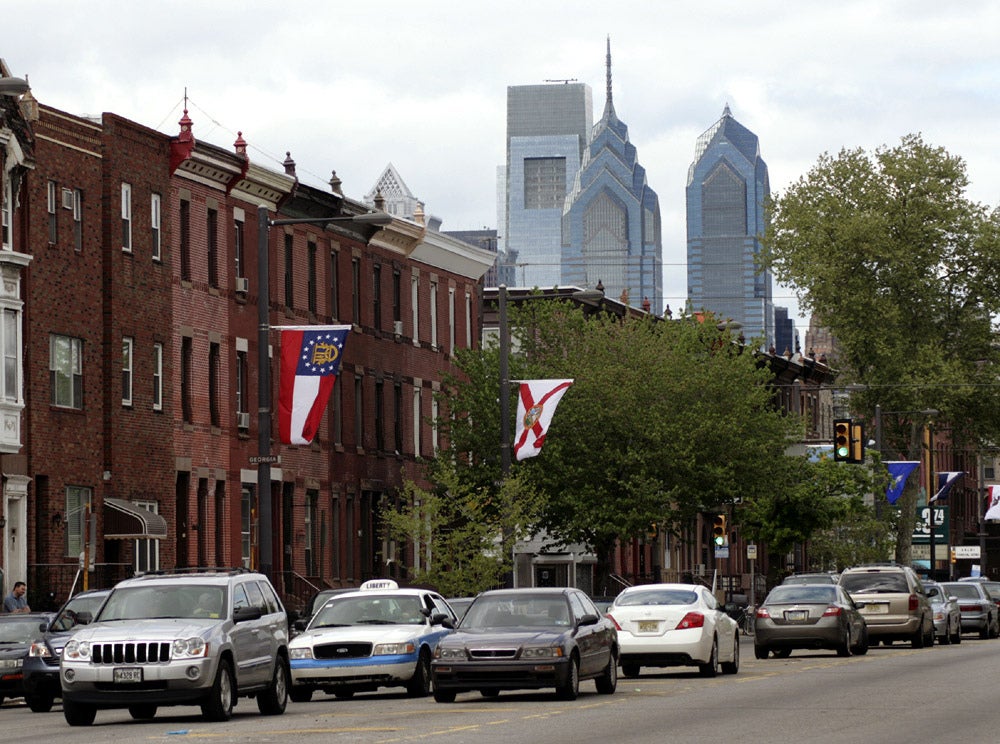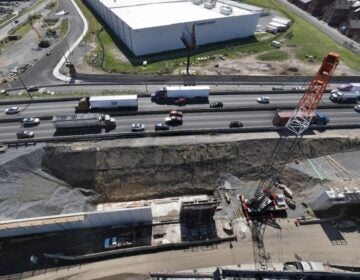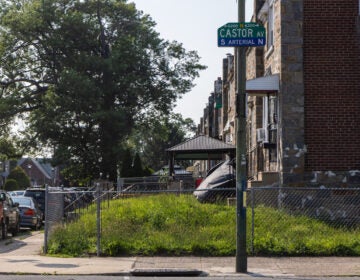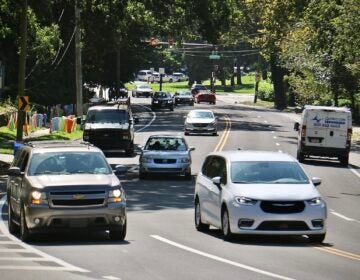Dear PennDOT: Save us from ourselves and remove South Broad’s parking median, permanently

As Philly gets ready to host Democrats, the city is tidying up. On South Broad that means a mural and parking ban for the center median. PlanPhilly transportation reporter Jim Saksa relfects on the tradition of parking in the center of South Broad and argues that if city politicians really wanted to get rid of parking in the median they could lean on PennDOT to do the dirty work when the street is resurfaced.
Growing up, word that my parents were expecting guests would always fill my gut with dread, as though the news of Grandma’s upcoming visit was printed on the front page of a fat Sunday edition thrown squarely at my breadbasket. Ugh, I would think, now I have to clean for, like, forever.
Like many children, I was not a fan of my parents’ completely unreasonable insistence that, say, used cups end up in the dishwasher, or that the cushions return uselessly to the sofa, even though they were the only thing keeping me from falling into a deadly sea of lava. As I grew older, I realized that my parents were far from the fastidious fascists my eight-year-old mind had made them out to be. Actually, they were kind of messy, too, and used the periodic social calls as a regular reminder to tidy up. In time, I grew to appreciate a neat room and orderly upholstery, especially when I’m entertaining the thought of entertaining.
Philadelphia, like myself and my parents, makes good use of expected guests to pick up a little bit. We saw it when the Pope came last year and we’re seeing it once again as the city readies itself for when the Democratic National Convention (DNC) drops by from July 25 to 28. In late June city officials announced a host of projects to spruce thing up, including a horizontal, mile-long mural running down the median of South Broad Street from City Hall to Washington Avenue.
This variegated vein, called “14 Movements: A Symphony in Color and Words” will beautify the concrete and cobblestone medians that serve as an isthmus between two violent rivers of traffic for pedestrians crossing PA Route 611. In theory, the median’s raised curbs also prevent cars from parking in the middle of the road, although some occasionally still do, especially closer to City Hall.
Further south, below Washington Avenue, the median islands disappears and parking in the middle of Broad Street becomes the norm rather than the abnormality. It’s a phenomenon that baffles newcomers to the city, much to the delight of jaded natives. That’s the case even though it’s technically illegal.
On Friday, the city announced that it would enforce that law the week of the DNC, due to expected throngs planning to march and protest down South Broad. The July 24 to July 29 ban will “ensure the safety of these demonstrators, as well as the police officers who will be protecting them.”
Of course, even without any unruly agitators parading down it, Broad Street is one of the most dangerous streets in the city, and nothing about parking in the middle of it makes it any safer.
But with the exception of temporary suspensions during special events, the conventional wisdom says parking in the middle of Broad Street is a sacred rite in this city, one no elected official shall dare interfere with, lest he’s after an early retirement. When asked about this issue during his mayoral campaign, Jim Kenney said it was a senseless, chaotic phenomenon that he had no interest in fixing. “You can never explain to a person why people park in the middle of Broad Street,” said Kenney. But: “I’m not going to be about changing that. That’s not on my agenda.” But there’s a way Philly politicians could end the practice soon without ending their careers early.
FOR AS LONG AS THERE HAVE BEEN CARS, THERE HAS BEEN PARKING IN THE CENTER OF SOUTH BROAD
Whenever the issue of parking on South Broad comes up, the inevitable rejoinder against ending the practice is some variant of “This is the way it’s always been done.”
This is unequivocally true. Philly Mag’s Dan McQuade did some digging last year and found a 1916 court case where the defendant testified that “the plaintiff suddenly appeared from among the automobiles parked in the central part of Broad street in front of his automobile and he could not avoid the accident.” [Emphasis added] McQuade also found a 1917 Automobile Trade News article with photos of cars parked on Broad’s median. This was at the dawn of the automotive age—you could argue that for as long as there have been cars, there has been parking in the middle of Broad Street. Or, as McQuade put it: “Yes, cars were parking in the middle of Broad Street literally 100 years ago.
“Whether you like or hate this practice — and, yes, the people who hate it are generally the most vocal — this is a Philadelphia tradition.”
Parking in the middle of Broad Street is a Philly rite of passage: It marks you as a Philadelphian.
I remember vividly the first time I parked in the middle of Broad. Carefully exiting my car to avoid having a truck plow both my door and me into oblivion, I thought to myself: I guess I can call myself a real South Philadelphian now. My grandmother may have grown up in Bella Vista, where her father was a Democratic ward leader, and met my grandfather at the Navy Yard, but I grew up on the Jersey Shore, making me a foreigner by Philly standards. For me, parking on Broad was the final question on my Philly naturalization exam.
Why did something as silly as parking in the middle of the road evoke such a sense of civic pride in me? It’s an unspoken rule. Or, perhaps more accurately, an unspoken exception to the written rule, which technically assesses a $31 fine for “Parked Improper—Two Way Highway”.
It’s like knowing where to find bars like Fiume, the Republican, or the R.U.B.A. It’s knowing Passyunk is pronounced “Pas-shunk”, calling I-476 the Blue Route, or taking the “R5” to the Main Line. It shows that you belong.
Friends of mine, visiting from other cities, assumed the practice required some sort of permit, reserving those spaces to residents only. In a way, they were right.
Left unchecked for a century now, that’s a lot of symbolism invested in something as asinine as parking on the middle of a busy road. But the sheer idiocy of allowing people to park in the median of a street where cars routinely travel 35 or 45 mph in the center lanes—the lanes car doors open into—doesn’t diminish the sense of kinship it bestows. Like a freshman’s drunken antics during pledging, the ridiculousness of parallel parking from a passing lane only adds to the feeling of Philadelphia fraternity.
I cherish tradition. Traditions bind us as a society, and define us as who we are. It isn’t our language, ethnicity, or religion that makes us Americans, it’s our shared ideals and culture, embodied by Fourth of July picnics and Thanksgiving Day parades. The same is true of Philadelphia, or any other place with a real sense of identity.
Parking in the middle of Broad Street is a Philadelphia tradition, one older than most in this town full of long-running rituals. Parking in the middle of Broad is also a fractious issue, and a source of mild embarrassment, not pride, for many Philadelphians. Traditions that stop binding us together, and start tearing us apart instead, cease to serve their purpose and it’s time to change.
If the city will ever get rid of the parking, it must happen by fiat, not enforcement. Enforcement would cause minor riots: Somehow, the PPA would be vilified even more than it is already, and accusations of revenue raising through unfairly targeted fines would be rampant. Enforcement didn’t work when Richardson Dilworth tried it and—notwithstanding the ensuing 50 years that saw the invention of transistors, landings on the moon, the fall of USSR, the rise of the internet, and the founding of the Flyers—things have not evolved so much South of Washington that enforcement would work now.
USE THE DOT AS A SHIELD
Neither Mayor Kenney nor the two councilmen whose districts use Broad Street as a border want to expend any political capital on this issue. Ending the practice would remove a tangible benefit those drivers feel, eliciting a strong and powerful emotional response psychologists call loss aversion and negativity bias. The pain of loss is greater than the pleasure of gain, and bad things motivate us more than commensurate good things. The pay off—appeasing some safety activists and saving a few lives—just aren’t worth the searing invective from irate residents who regularly rely on the middle of Broad parking lot.
Understandably averse to career suicide, local politicians won’t act. It will take someone else to fix South Broad Street.
Thankfully, PennDOT owns the street. The faceless Harrisburg bureaucracy could provide the mayor and city council political cover: They should quietly petition PennDOT to replace the merely painted median with a raised median.
Raised median curbs with ramps for strollers and wheelchairs would help pedestrians cross safely. It would also allow PennDOT to retain left turn lanes at certain intersections, so it wouldn’t interfere with traffic flows. The added cost to build would be negligible; the safety benefits, substantial.
Removing parked cars from South Broad would take away about 200 “parking spots” between Washington and Oregon, based a simple hand count. While that’s not an insignificant amount of lost parking places, the pain would be spread out over 16 city blocks.
The city refused to comment on this idea. For their part, PennDOT says they’ll go along with whatever the city wants. “PennDOT doesn’t typically interfere on municipal parking matters, in the City or elsewhere,” PennDOT spokesman Brad Rudolph said in an email. “In this case, PennDOT would not have any interest in maintaining a constructed median along South Broad, so it really would fall on the City to pursue something here – with a commitment to maintain it.”
The time to act is fast approaching. The only financially sensible time to redesign South Broad would be when the street is up for resurfacing. PennDOT usually resurfaces roads every 10 years, and Broad Street south of Washington was last repaved in 2010. Throw in a year or two for engineering and design work, and Philadelphia has a little bit over a year to act.
A few quiet phone calls from the Mayor and the local councilmen to PennDOT, urging the state agency to build a median—and ignore their subsequent grandstanding against it—would let the local politicians save face while removing this dangerous, if beloved, safety hazard. PennDOT would bear the brunt of residents’ ire.
THAT’S AN ODD PLACE TO DO THAT…
In the apartment where I live in now, a rowhouse in Point Breeze, there is a toilet in the back laundry room between the kitchen and my small back patio. No sink, just a toilet next to a washer and dryer, and a clear, drapeless window to the backyard. It’s a comical set up. My friends laugh about it every time they come over for a cookout. No matter how much I spruce up my apartment, no matter how perfectly cooked the ribs, that toilet remains the most memorable part of everyone’s visit. I’m Jim, the guy with the out-of-place toilet.
Parking in the middle of Broad Street is that toilet. Philadelphia can put out the bunting, roll out the red carpet, paint and scrub and clean all it wants. But as long as cars continue to park on South Broad, that’s what Philly will be: the city with the ridiculously-placed parking.
WHYY is your source for fact-based, in-depth journalism and information. As a nonprofit organization, we rely on financial support from readers like you. Please give today.







